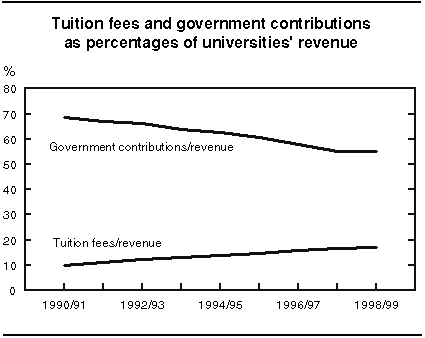
















 |
|
 |                |
Archived ContentInformation identified as archived is provided for reference, research or recordkeeping purposes. It is not subject to the Government of Canada Web Standards and has not been altered or updated since it was archived. Please "contact us" to request a format other than those available. 
The Daily. Monday, August 28, 2000 University tuition fees2000/2001Undergraduate arts students will pay an average of 3.0% more in university fees for the 2000/01 academic year. This increase is smaller than those of previous years, as more provinces have frozen tuition. This fall, undergraduate arts students will pay on average $3,380 in tuition, up 3.0% from $3,281 in 1999/00. The 2000/01 level is more than double the average tuition of about $1,500 at the beginning of the 1990s. The 2000/01 rate of growth represents a significant slowing of the average annual increase, which has been nearly 9% during the last five years. Tuition fees will be frozen this fall at universities in several provinces, including Newfoundland, Prince Edward Island, Quebec (for residents only) and in British Columbia (public institutions only) for the sixth consecutive year. Manitoba students are receiving a 10% rebate from the provincial government for 2000/01. Average increases in tuition for 2000/01 across Canada range between 3% and 7%, compared with annual average increases of between 7% and 12% during the past five years. Fees at universities in Quebec will be frozen for the fourth year at $1,668 for Quebec residents. However, students from other provinces attending Quebec universities face a 7.8% increase in tuition this fall. Tuition fees will increase at universities in five provinces: Saskatchewan, Nova Scotia, Ontario, Alberta and New Brunswick. The highest average increase, 7.7%, will be in Saskatchewan. However, average undergraduate arts fees in Nova Scotia, at $4,408, will be the highest in Canada. The average undergraduate arts tuition at Ontario universities, $3,971, remains the nation's second highest. While the average 2.7% fee increase at Ontario universities this fall is only slightly below the national average, it falls well below Ontario's average annual growth rate of 11.5% during the previous five years. Reduced government funding partly offset by higher tuition feesTuition fees increased during the 1990s, as universities attempted to make up for reductions in government funding. Undergraduate arts fees since 1990/91 have more than doubled in all provinces except Prince Edward Island, New Brunswick and British Columbia. The largest increase occurred in Alberta, where average tuition fees for undergraduate arts students have more than tripled from $1,244 to $3,841. The lowest undergraduate fees in Canada will be for university students who are residents of Quebec; they will continue to pay less than half the tuition fees of those in other provinces in virtually all fields of study. British Columbia had the lowest overall arts tuition fee increases during the previous decade - less than 50% from $1,727 to $2,520. British Columbia now has the second-lowest average arts fees, after Quebec. According to the most recent data on university finances, released in The Daily on July 25, government funding to universities increased in 1998/99 for the first time since 1992/93. As a result, government grants and contracts accounted for 55% of total university revenue in 1998/99, unchanged from the previous year, following nearly two decades of steady decline. In 1981/82, government contributions made up 74% of university revenues. In 1998/99, tuition fees for credit courses made up 17% of university revenue, more than double the proportion of 8.3% in 1981/82. 
Law, music programs see largest fee increasesThe two faculties with the largest fee increases for 2000/01 will be law, (+18.2%), and music (+11.3%). Dentistry and medicine remain the most expensive programs in terms of average tuition. Students in dentistry will pay $7,678 on average this fall, up 6% from 1999/00. Those in medicine will pay $5,975 on average, a 5.8% increase. Average dentistry fees will be highest in Saskatchewan and Ontario. Tuition fees for medicine will be highest in Newfoundland and Ontario. Average tuition fees(1)
Graduate fees rise more rapidlyFor the fourth consecutive year, graduate students will face higher average fee increases than their undergraduate counterparts. In 2000/01, they will pay $3,961 in tuition, up 12.5% from the previous year. Since 1996/97, graduate students have seen tuition fees rise about 13% per year, compared with 8% a year for undergraduates. Graduates' fee increases are largest in Nova Scotia, Ontario and Alberta. Many public universities froze tuition for foreign students at the undergraduate and/or graduate level for the coming school year. The exceptions are Nova Scotia, New Brunswick, Ontario and Alberta, where fees for foreign students increase between 3% and 20%, depending on the institution and field of study. Information is also available on additional compulsory fees and the cost of accommodation on campus. For tables or general inquiries, contact Sharon-Anne Borde, (613-951-1503; sharon.borde@statcan.gc.ca). For more information, or to enquire about the concepts, methods or data quality of this release, contact Peter Elliott (613-951-4551; peter.elliott@statcan.gc.ca), Centre for Education Statistics. Average undergraduate arts tuition(1)
| |||||||||||||||||||||||||||||||||||||||||||||||||||||||||||||||||||||||||||||||||||||||||||||||||||||||||||||||||||||||||||||||||||||||||||||||||||||||||||||||||
|
|
|